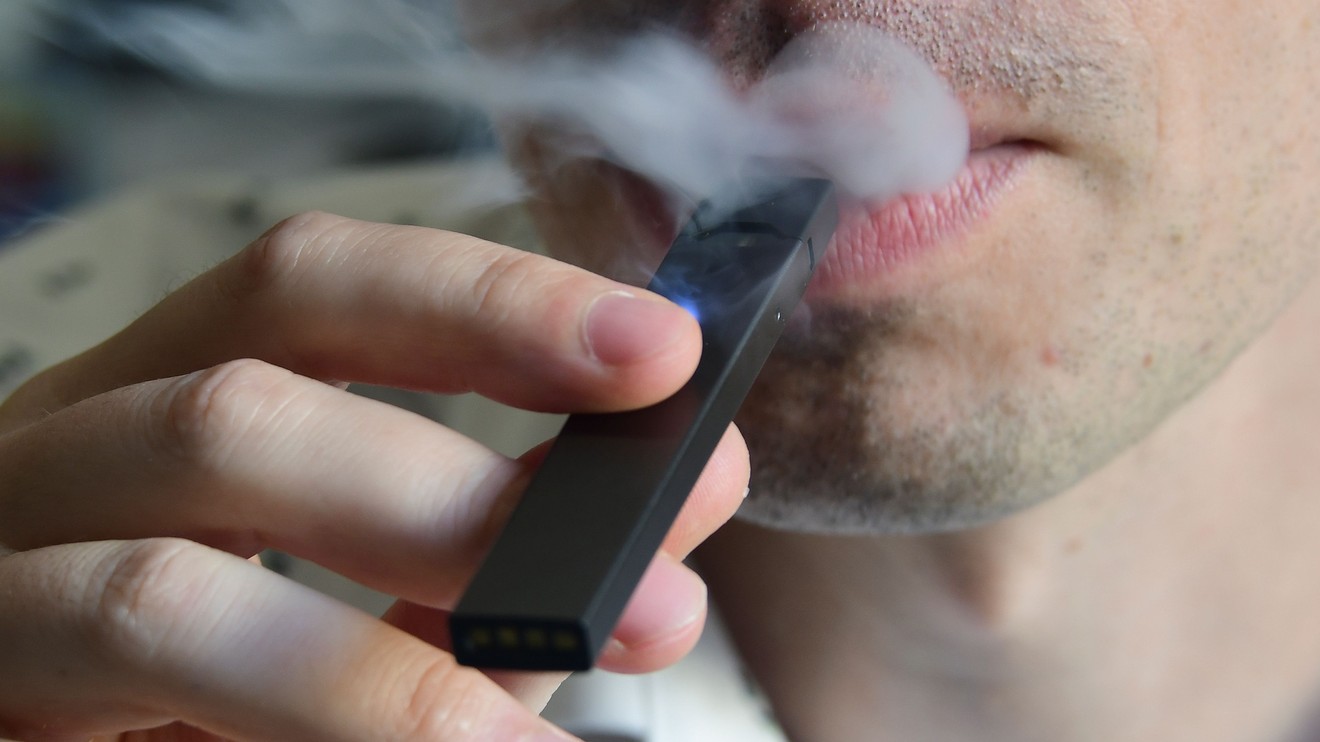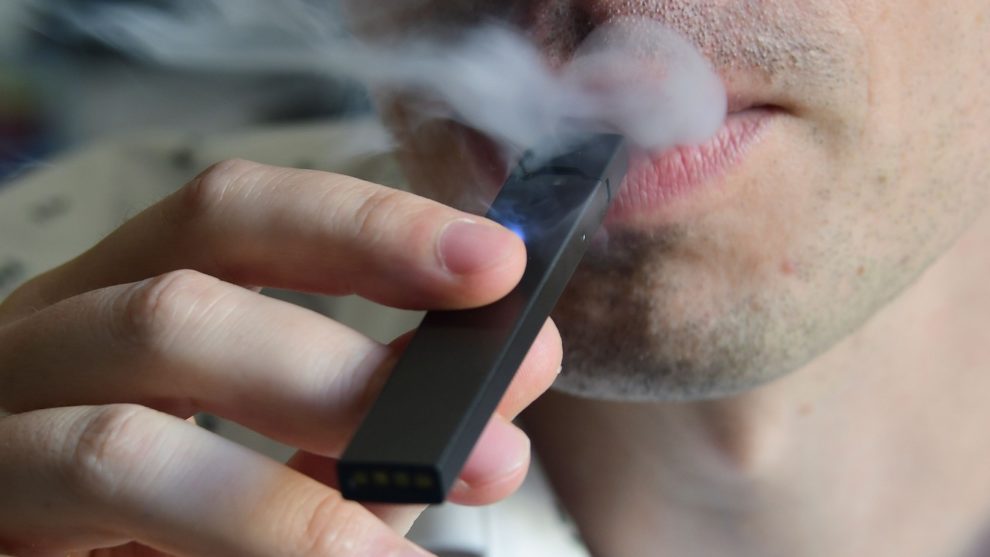
Many cigarette smokers trying to wean themselves off combustible tobacco have turned to e-cigarettes. But some e-cigarette users are also trying to quit — including those who use Juul, the sleek but highly concentrated nicotine vape pen popular among teens.
House lawmakers in July questioned Juul Labs co-founder James Monsees over the company’s role in what the previous Food and Drug Administration commissioner dubbed an “epidemic of addiction” among teenagers. “We never wanted any non-nicotine user, and certainly nobody underage, to ever use Juul products,” Monsees said. “Yet the data clearly shows a significant number of underage Americans are doing so. This is a serious problem. Our company has no higher priority than fighting it.”
Approximately 1.5% of high-school students used e-cigarettes in 2011, but that percentage rose to 20.8% in 2018, according to the CDC.
Now health officials have linked a vaping-related lung illness sweeping the country to three deaths and a reported 450 suspected or confirmed cases, according to NBC News. The New York State Department of Health also announced Thursday that it had found high levels of the supplement vitamin E acetate, in cannabis-containing vape products submitted for testing.
“While this investigation is ongoing, people should consider not using e-cigarette products,” the CDC said Friday. “People who do use e-cigarette products should monitor themselves for symptoms (e.g., cough, shortness of breath, chest pain, nausea, vomiting, abdominal pain, fever) and promptly seek medical attention for any health concerns.”
Teens also testified in a hearing that a Juul representative had once claimed to ninth-grade students that the USB-shaped device was “totally safe.” The e-cigarette company called the presentation part of a “short-lived Education and Youth Prevention Program” discontinued last September “after its purpose — to educate youth on the dangers of nicotine addiction — was clearly misconstrued.”
Cost is also an issue
E-cigarettes are not cheap. Dave Dobbins, the chief operating officer of Truth Initiative, an anti-tobacco nonprofit, says his organization has heard from plenty of kids who say they spend $50 a month on Juul pods, and has even heard of monthly tabs running into the hundreds. Because online buyers must be 21 or older, teens often buy the product — whose 5% nicotine pods sell for $15.99 per four-pack — at inflated resale rates. One pod is supposed to last around 200 puffs.
“When you’re working part-time at a pizza place, that’s a big deal,” Dobbins said. “One of the things we talk about with kids is, ‘Is this really where you want to spend your money?’”
Teen use has soared
Some 1.5% of high-school students used e-cigarettes in 2011, but that percentage rose to 20.8% in 2018, according to the Centers for Disease Control and Prevention, and increased from 0.6% to 4.9% among middle schoolers over the same period. High schoolers’ e-cigarette use shot up by 78% between 2017 and 2018 alone, while middle-schoolers’ use increased 48% — a trend likely due to “the recent popularity of e-cigarettes shaped like a USB flash drive, such as JUUL,” the CDC suggested.
Juul, whose pods come in flavors like mango and mint and can contain roughly one pack of cigarettes’ worth of nicotine, became a teen favorite in part because of its range of appealing flavors and the ease of using it without parents’ knowledge, said Donna Shelley, a professor of population health and medicine at the NYU School of Medicine.
The ease of delivery, amount of nicotine per pod, and frequency with which young people can now use the product “all add up to a product that is leading to a new epidemic of nicotine addiction among youth,” Shelley told MarketWatch.
There’s concern that e-cigarettes, which are not FDA-approved as a smoking-cessation aid, could serve as a gateway to cigarette smoking.
It’s “super discreet,” Dobbins said. “You can use it all the time: in school, in your bedroom, in the middle of the night, when you wake up.”
Juul Labs did not return a MarketWatch request for comment on the product’s addictiveness, particularly among teens.
E-cigarettes are “absolutely less harmful than combustible tobacco,” Shelley said, and there’s increasing evidence that they can help people quit smoking cigarettes. (Results have been mixed.)
But there’s still concern that e-cigarettes, which are not FDA-approved as a smoking-cessation aid, could serve as a gateway to cigarette smoking, Shelley said. A JAMA Network Open study published in February concluded that “e-cigarette use is associated with increased risk for cigarette initiation and use, particularly among low-risk youths.” Cigarette smoking is, of course, the top risk factor for lung cancer.
“Using nicotine in adolescence can harm the parts of the brain that control attention, learning, mood, and impulse control,” the CDC adds. “Each time a new memory is created or a new skill is learned, stronger connections — or synapses — are built between brain cells. Young people’s brains build synapses faster than adult brains. Nicotine changes the way these synapses are formed.”
If you’re looking to kick your e-cigarette or Juul habit, you’re not alone: Research shows that a majority of e-cigarette users want to quit.
Some 63% of Juul users in a 2018 Truth Initiative study were unaware that the product always contained nicotine, according to a 2018 study.
Here are strategies that can help, according to experts:
Get informed. Some 63% of Juul users in a 2018 Truth Initiative study were unaware that the product always contained nicotine. On the flip side, a JAMA Network Open study this year found that the share of U.S. adults perceiving e-cigarettes to be just as harmful as or more harmful than cigarettes rose “substantially” between 2012 and 2017.
Find a support system. If you’re a light user, quitting cold turkey and/or quitting with a support group could be the best option, Stanton Glantz, a professor of medicine at the University of California, San Francisco, told MarketWatch. For heavier users, however, it may not be so easy.
Get access to an online community in which people support one another, share tips and success stories, and acknowledge that quitting can take multiple attempts, Dobbins added. This kinship among users who are trying to quit together “gives a sense of community and bolsters your ability to quit,” he said.
Quit by text. The Truth Initiative’s free text-message tool launched this year as a resource for young e-cigarette and Juul users trying to quit. (Text DITCHJUUL to 88709.) The program, which uses input from young adults who have quit or tried to quit using e-cigarettes, gives age-appropriate tips and support leading up to a target quit date, providing an “instant boost” whenever the user texts “CRAVE,” “SLIP” or “STRESS.” The tool also integrates with the Truth Initiative’s digital quit programs This Is Quitting and BecomeAnEx.
If you’re a moderate user, try nicotine-replacement therapy (NRT) like nicotine gum, lozenges or skin patches, Glantz said. But while many NRTs can be obtained over the counter, Glantz warns they should still be used in conjunction with counseling, as research suggests they aren’t effective on their own. “The studies very consistently show that the counseling is crucial,” he said. “The emotional-support part of this is very, very important.” You can access those resources through SmokeFree.gov or state quitlines, many of which offer free NRT, he said.
For a more severe addiction, see your health-care provider. They may recommend a prescription medication like varenicline (brand name Chantix PFE, +0.37% ) or bupropion (brand names Zyban GSK, +0.19% , Wellbutrin or Aplenzin BHC, +2.28% ) to help you quit, Glantz said. “Those are more potent prescription drugs that are appropriate for people who are more seriously addicted,” he said. “You wouldn’t want to start with those.” Medications should also be used alongside counseling. And as always with such drugs, read the potential side effects carefully.
Work to change your behaviors. People come up with their own plans, but many have the same overarching themes, Shelley said, including trying to make the act unpalatable and making sure they have alternative behaviors that are satisfying and fulfill that need.
Strategies might include chewing on gum, cinnamon sticks or candy to keep your mouth busy; learning to anticipate which people, situations and emotions trigger use; working to wait out the ebb and flow of cravings; and creating a plan for the tough times, Shelley said.
“Some of it is really just having something to put in your mouth,” she said. “Other times it’s more about having someone to talk to or positive thinking.” Another tip: Keep e-cigarettes out of your home and try to steer clear of people who use them, Shelley added, though the latter could be difficult if they’re popular among your peer group.
Don’t lose hope. “It’s very important, even if you don’t succeed on the first try, to keep trying,” Glantz said. “A lot of people relapse, and you just need to keep trying until you succeed.”











Add Comment